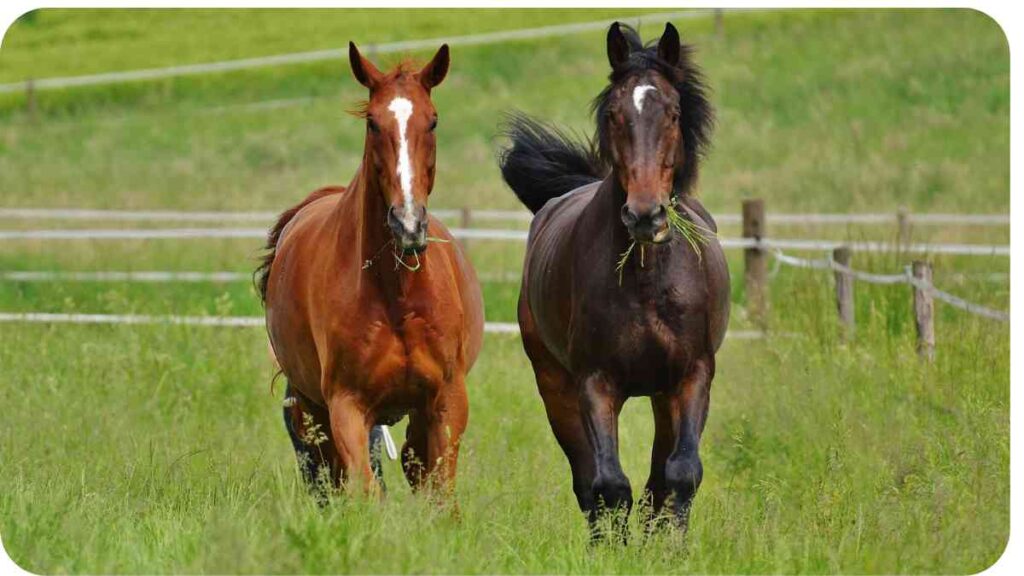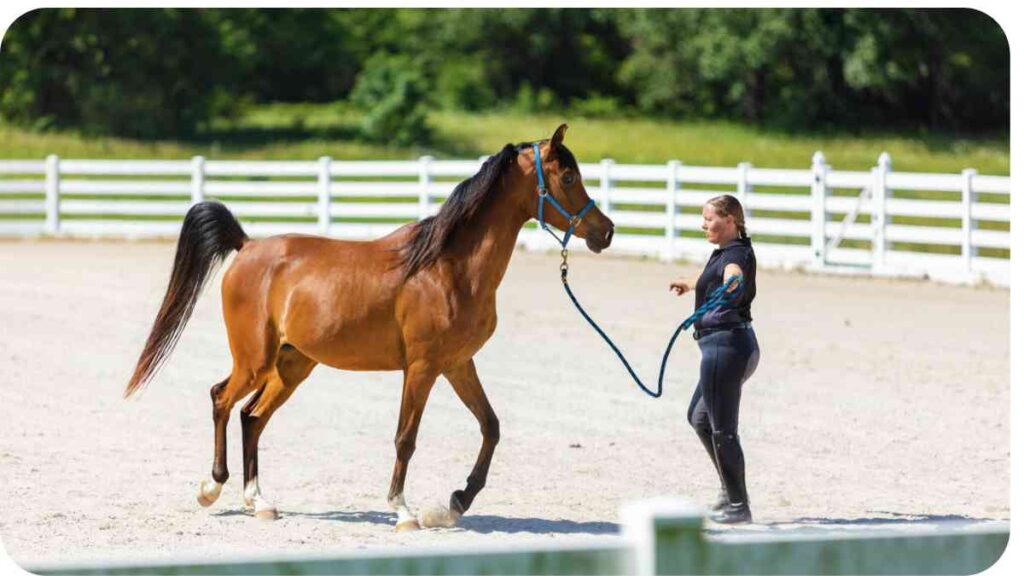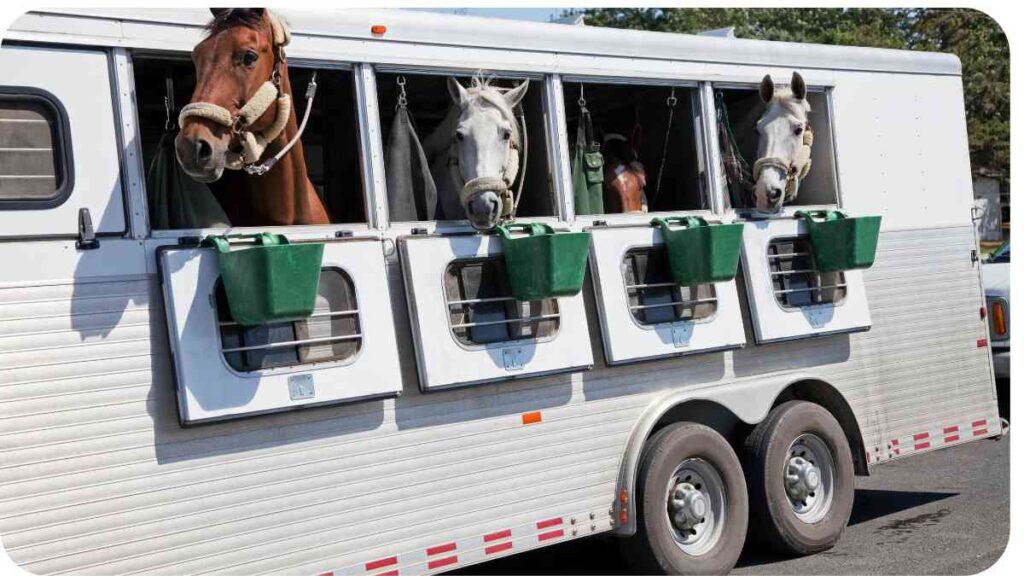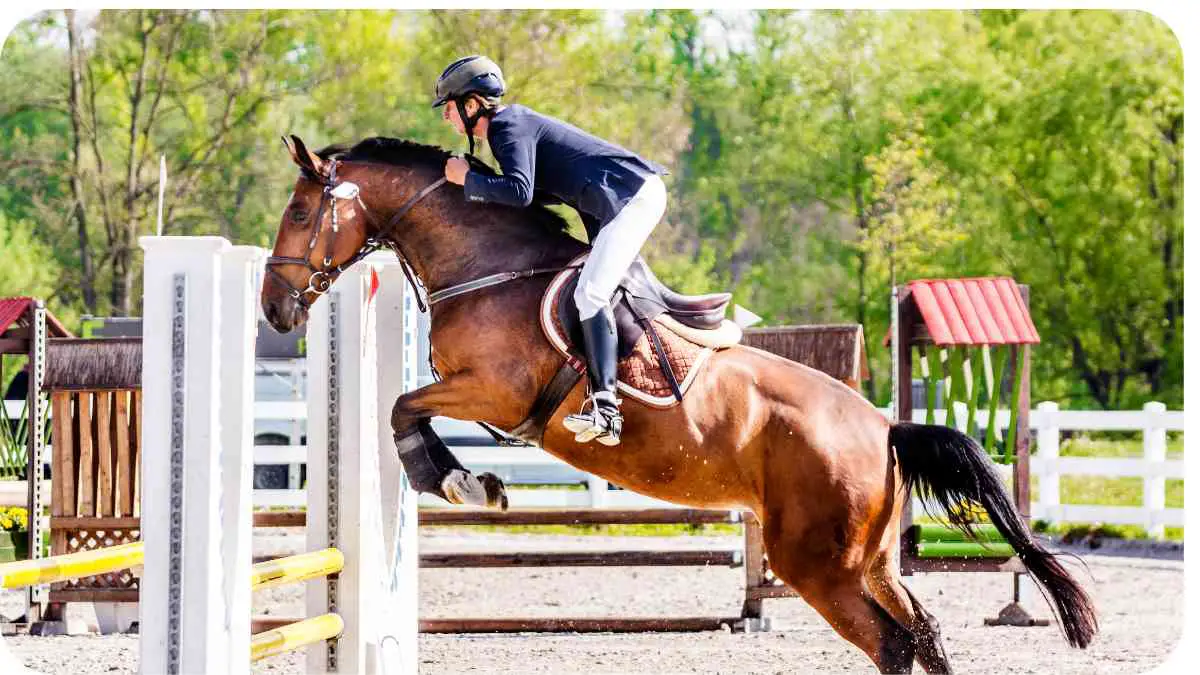Welcome to the ultimate guide on horse show preparation! In this article, we will cover all the essential steps and considerations to ensure a successful and enjoyable horse show experience. Whether you’re a seasoned competitor or a novice rider, proper preparation is key to achieving optimal performance and creating a positive experience for both you and your horse.
Throughout this guide, we will delve into various aspects of horse show preparation, sharing insights, tips, and anecdotes based on our expertise and experience in the field.
We’ll begin by discussing the initial steps necessary to get started and progress towards more specialized topics that cover aspects such as horse selection, health examination, grooming and tack preparation, fitness training for both the horse and rider, show scheduling, mental preparation, and much more.
| Takeaway |
|---|
| Proper preparation is key to a successful horse show |
| Organize your show supplies for easy access |
| Ensure your horse is safely and comfortably transported |
| Familiarize yourself with the show venue upon arrival |
| Establish a thorough warm-up routine for you and your horse |
| Display good sportsmanship and adhere to show etiquette |
2. Getting Started
Before you set off on your horse show journey, it’s important to take a moment to define your goals and aspirations. What type of horse shows are you interested in? Are you aiming for local competitions or perhaps dreaming of competing at higher levels? Understanding your objectives will help you establish a clear path and make informed decisions as you progress.
Once you’ve established your goals, it’s time to define your budget. Horse shows can vary in terms of costs, so having a budget in place will allow you to plan your expenses accordingly. Consider expenses like entry fees, transportation, stabling, grooming supplies, and even professional assistance if needed.
To give you a clearer picture of the expenses you might encounter, here is a table outlining the different cost categories and average price ranges:
| Cost Category | Average Price Range |
| Entry Fees | 300 |
| Stabling | 500 |
| Transportation | 1000 |
| Grooming Supplies | 150 |
| Professional Assistance | 500 |
Keep in mind that these price ranges may vary depending on factors such as the level of competition, location, and type of show, so it’s important to do some research and consider your specific circumstances.
3. Selecting the Right Horse

Choosing the right horse for the show is absolutely crucial. Your horse should be suitable for the discipline you wish to compete in, possess the necessary training, and have a temperament that complements your riding style. You may want to consult with trainers, professionals, or experienced riders who can offer valuable guidance in determining the best fit for you.
“If you’re exploring different horse breeds, learn more about their characteristics and history in our comprehensive guide on horse breeds.
4. Examining Horse Health
The health and well-being of your horse are of utmost importance. Before engaging in any competitive activities, it’s essential to ensure that your horse is in good health and free from any injuries or illnesses. Regular veterinary check-ups, vaccinations, and dental care are key to maintaining your horse’s overall well-being.
It’s also important to monitor your horse’s weight, nutrition, and exercise routine to ensure they are in optimal condition for the show. Working closely with your veterinarian and equine nutritionist will help you devise a proper diet and fitness plan tailored to your horse’s specific needs.
5. Grooming and Tack Preparation
Proper grooming and tack preparation are essential for both the physical comfort and visual appearance of your horse. Regular grooming not only helps maintain a healthy coat and skin but also allows you to bond with your horse.
When it comes to tack preparation, ensuring that all your equipment is clean, in good condition, and properly fitted is vital. Ill-fitting tack can lead to discomfort, pain, and even injuries for your horse. Take the time to check and adjust your saddle, bridle, and other equipment to provide maximum comfort and safety for both you and your horse.
Discover the secrets to success in your next horse show with our expert tips in this article on winning horse shows
Table: Essential Grooming Supplies
| Grooming Supplies | Purpose |
| Curry comb | Removes dirt and loose hair |
| Body brush | Sweeps away dust and promotes shine |
| Mane comb | Detangles and maintains mane |
| Hoof pick | Cleans hooves and checks for debris |
| Grooming mitt | Enhances shine and stimulates circulation |
| Fly repellent | Protects against flies and insects |
| Horse shampoo | Cleans and conditions the coat |
| Sweat scraper | Removes excess water after bathing |
| Mane and tail detangler | Eases combing and prevents breakage |
Remember, grooming not only enhances your horse’s appearance but also allows you to inspect their coat, hooves, and overall health. Regular grooming sessions can also create a sense of relaxation and bonding between you and your horse.
6. Fitness Training for the Horse

In preparation for the show, it’s crucial to focus on your horse’s fitness. Just like athletes, horses require regular exercise to build stamina, strength, and flexibility. Consult with your trainer or equine fitness specialist to develop a tailored training program that aligns with your horse’s discipline and competition goals.
Training sessions should include a mix of cardiovascular exercise, flatwork, gymnastic exercises, and jumping practice, depending on the type of competition you’ll be participating in. Gradually increase the intensity and duration of the workouts, allowing your horse to build up their endurance and perform at their peak during the show.
Planning to travel with your horse for competitions? Check out our guide on traveling with horses to ensure a smooth journey.
7. Rider Fitness and Training
While your horse’s physical fitness is essential, don’t forget about your own! As a rider, your fitness levels, balance, and coordination directly impact your performance and ability to communicate effectively with your horse. Incorporate exercises that improve your core strength, flexibility, and overall fitness to enhance your riding abilities.
Consider working with a personal trainer or joining a fitness program specifically designed for riders. Exercises like yoga, pilates, and cardio workouts can greatly improve your riding posture, balance, and stability in the saddle.
To provide you with a visual representation of a typical weekly training schedule for both horse and rider, here’s a table outlining the activities and duration:
| Day | Horse Training | Rider Training |
| Monday | Flatwork: 30 minutes | Yoga: 45 minutes |
| Tuesday | Gymnastic exercises: 45 minutes | Cardio workout: 30 minutes |
| Wednesday | Rest or light hack | Rest or light workout |
| Thursday | Jumping practice: 1 hour | Strength training: 45 minutes |
| Friday | Flatwork and pole exercises: 45 minutes | Core exercises: 30 minutes |
| Saturday | Trail ride or schooling in a different environment | Flexibility exercises: 30 minutes |
| Sunday | Rest or light hack | Rest or light workout |
This schedule serves as a general guideline and can be adjusted based on your specific needs, competition schedule, and the advice of your trainer or coach.
Effective ground work is essential in horse training. Find out why it matters in our article about ground work.
8. Planning the Show Schedule
When planning your show schedule, consider factors such as the level of competition, your horse’s readiness, and your availability. Start by selecting shows that align with your goals, and progressively work towards more challenging events as you and your horse gain experience and confidence.
Ensure you have ample time to prepare and train for each show. Rushing into competitions without proper preparation can lead to unnecessary stress and hinder your horse’s performance. Take into account any other commitments or time constraints you may have, such as work or family obligations.
It’s also important to research the show venues and their facilities. Look for shows that provide appropriate stabling, warm-up areas, and amenities for both horses and riders. Being comfortable and familiar with the show environment can greatly contribute to a positive experience.
Table: Show Schedule and Preparation Checklist
| Show Date | Show Venue | Preparation Checklist |
| May 15 | Local Arena | – Complete horse health check-up |
| – Pack show supplies (tack, grooming kit, etc.) | ||
| – Check transportation arrangements | ||
| – Plan show outfit and attire | ||
| July 3 | Regional Show | – Schedule training sessions leading up to the show |
| – Polish and clean tack | ||
| – Review show rules and regulations | ||
| – Check show schedule and entry deadlines | ||
| September 8 | National Show | – Fine-tune riding technique and implement feedback |
| – Practice dressage test and jumping courses | ||
| – Prepare necessary paperwork (passports, registrations) | ||
| – Compile a checklist for show day essentials |
By setting a clear show schedule and following a preparation checklist, you’ll have a systematic approach that ensures you’re ready for each event. Remember to always double-check all the details and stay organized to avoid any last-minute surprises.
9. Preparing for the Show
As the show date approaches, there are several key aspects to consider to ensure a smooth and stress-free experience. Pay attention to your horse’s exercise routine, keeping them in peak condition without overexertion. Fine-tune your riding technique and practice specific show elements, such as dressage tests or jumping courses.
Organize your show supplies, including tack, grooming kit, show attire, and any necessary paperwork or documentation. Prepare a checklist to ensure you have everything you need on show day, minimizing the chances of forgetting important items.
Before hitting the trails, it’s crucial to understand horse riding etiquette. Learn the dos and don’ts to ensure a safe and enjoyable riding experience.
Table: Show Day Essentials Checklist
| Category | Checklist |
| Horse Supplies | – Bridle, saddle, and appropriate bit |
| – Saddle pad and numnah | |
| – Clean and polished boots or bandages | |
| – Fly repellent and grooming supplies | |
| – Water buckets and hay | |
| – First aid kit for horses | |
| Rider Supplies | – Show jacket or coat |
| – Riding helmet and gloves | |
| – Clean and polished boots | |
| – Show shirt and tie or stock tie | |
| – Number bib or competition identifier | |
| – Personal grooming items (hairnet, makeup) | |
| Administrative | – Horse passports or registrations |
| – Show entry forms and proof of payment | |
| – Membership or identification cards | |
| – Emergency contact list | |
| – Show schedule and course maps | |
| – Water, snacks, and cash |
Being well-prepared and organized allows you to focus on the competition without unnecessary distractions or stress.
10. Mental Preparation
Horse shows can be mentally challenging, so it’s crucial to prepare yourself mentally and emotionally. Confidence is key when entering the show ring, and there are several strategies you can employ to enhance your mental preparedness.
Visualize success and positive outcomes during your training sessions and even in your day-to-day life. Develop strategies to manage stress or anxiety, such as deep breathing exercises or positive self-talk. Surround yourself with a supportive network of fellow riders, friends, or family members who can offer encouragement and provide a calming presence.
Remember, horse shows are not just about winning ribbons but about personal growth, improvement, and enjoying the experience with your equine partner. Embrace the opportunity to learn from each show, regardless of the results, and celebrate the progress you make.
11. Organizing Show Supplies
To ensure a smooth and efficient show experience, it’s important to organize your show supplies in a structured and easily accessible manner. This will allow you to quickly locate items when needed and reduce the chances of forgetting essential equipment.
Consider using a dedicated show trunk or bag to store all your show supplies. Here are some tips for organizing your show supplies:
- Tack: Keep all your tack clean and well-maintained. Store it in a protective bag or cover to prevent damage or scratching.
- Grooming Supplies: Use a grooming tote or box with compartments to keep grooming tools organized. Separate items such as combs, brushes, and hoof picks for easy access.
- Show Attire: Hang your show attire neatly on hangers or use a garment bag to keep them clean and wrinkle-free.
- First Aid Kit: Make sure you have a well-stocked first aid kit specifically for your horse. Include items like bandages, antiseptic ointment, and wound dressings.
- Personal Items: Keep your personal items, such as rider attire, grooming tools, and necessary paperwork, in a separate compartment or bag for easy access.
By keeping your show supplies organized, you’ll save time and minimize stress when preparing for and attending horse shows.
12. Transporting the Horse

Transporting your horse to the show venue requires careful planning and attention to detail. Safety and comfort should be your top priorities throughout the transportation process. Here are some key considerations and tips for transporting your horse:
- Horse Trailer Inspection: Before each trip, thoroughly inspect your horse trailer for any signs of damage, ensuring it’s clean and in good working condition. Check the tires, brakes, lights, and ventilation systems. Make any necessary repairs or maintenance before the scheduled trip.
- Secure Loading and Unloading: Train your horse to load and unload calmly and safely. Practice these procedures regularly to ensure your horse remains comfortable and cooperative throughout the process. Use appropriate safety equipment like lead ropes and protective boots.
- Stable and Tie: Ensure your horse is securely tied or appropriately unfastened with a quick-release mechanism during transportation. Monitor your horse’s well-being throughout the journey and make any necessary stops for rest, hydration, and feeding.
- Arrival Preparation: Upon arrival at the show venue, set up your horse’s stall or stable with appropriate bedding, water, and hay. Allow your horse some time to acclimate and rest before engaging in further activities or warm-ups.
- Return Transportation: After the show concludes, provide your horse with ample rest and recovery time before transporting them back home. Follow the same safety procedures during the return journey, ensuring your horse’s well-being is prioritized throughout.
By ensuring your horse’s safety and comfort during transportation, you’ll set the stage for a successful show experience.
13. Arriving at the Show
When you arrive at the show, it’s important to familiarize yourself with the surroundings and get organized before your scheduled events. Here are some steps to take upon arrival:
- Check-In: Locate the show office and complete any necessary check-in procedures, such as obtaining your rider number or submitting required paperwork.
- Stabling: Settle your horse into the assigned stall or stable, ensuring they have fresh water, ample bedding, and a secure environment. Unload your horse’s tack and grooming supplies.
- Warm-Up Area: Familiarize yourself with the showgrounds, including the warm-up area and practice fences. Observe any rules or restrictions provided by the show management.
- Schedule Review: Double-check the show schedule and confirm the specific times and locations of your events.
- Course Walk: If there are jumping courses involved, take the opportunity to walk the course, study the design, and plan your riding strategy.
- Connect with Others: Introduce yourself to fellow riders, trainers, and show staff. Building connections and establishing a network of support can enhance your show experience.
Allow yourself enough time to settle in and mentally prepare for your upcoming events. Staying organized and aware of the show’s schedule and surroundings will help you navigate the day smoothly.
14. Pre-Competition Warm-Up
Before entering the show ring, it’s important to warm up both yourself and your horse. A proper warm-up routine ensures that you and your horse are physically prepared for optimal performance. Follow these guidelines for an effective warm-up:
- Horse Warm-Up: Begin with a few minutes of walking to loosen up your horse’s muscles. Then, transition to trotting and cantering, gradually increasing the intensity. Incorporate some bending, lateral movements, and transitions to engage your horse’s body and mind. Pay attention to their responsiveness and overall well-being throughout the warm-up.
- Rider Warm-Up: Prioritize your own warm-up to ensure you’re mentally and physically prepared for your upcoming
competition. Engage in light stretching exercises to warm up your muscles, focusing on areas such as your legs, core, and upper body. Practice some basic riding exercises, such as circles, transitions, and lateral movements, to fine-tune your riding skills and establish a connection with your horse.
Remember, the warm-up is not the time to introduce new training techniques or push for maximum performance. Instead, it’s an opportunity to limber up, establish a rhythm, and build confidence for the upcoming competition.
15. Show Etiquette and Sportsmanship
Participating in horse shows requires adherence to proper show etiquette and the demonstration of good sportsmanship. Show etiquette ensures a respectful and positive environment for all participants and spectators. Here are some essential aspects of show etiquette:
- Punctuality: Arrive at the designated rings and competition areas on time. Respect the scheduling and be prepared for your assigned events.
- Ring Etiquette: Always yield the right of way to other riders, and wait for your turn to enter the show ring. Maintain a safe distance between horses and avoid abrupt movements that may startle other horses.
- Conduct: Display good sportsmanship by congratulating and supporting fellow competitors, regardless of the final results. Avoid making derogatory comments or displaying unsportsmanlike behavior towards other riders.
- Arena Maintenance: After your ride, promptly leave the show ring to allow the next rider to enter. Clear any debris or manure left behind by your horse to maintain a clean and organized arena for all participants.
- Appropriate Attire: Follow the dress code and requirements set by the show organizers. Dress neatly and professionally, ensuring your attire is suitable for the specific discipline and level of competition.
Demonstrating good sportsmanship and adhering to proper show etiquette not only reflects positively on you as a rider but also contributes to a positive and enjoyable show experience for everyone involved.
To summarize the important points discussed, here are the tables provided throughout the guide:
Table: Essential Grooming Supplies (continued)
| Grooming Supplies | Purpose |
| Curry comb | Removes dirt and loose hair |
| Body brush | Sweeps away dust and promotes shine |
| Mane comb | Detangles and maintains mane |
| Hoof pick | Cleans hooves and checks for debris |
| Grooming mitt | Enhances shine and stimulates circulation |
| Fly repellent | Protects against flies and insects |
| Horse shampoo | Cleans and conditions the coat |
| Sweat scraper | Removes excess water after bathing |
| Mane and tail detangler | Eases combing and prevents breakage |
Table: Show Day Essentials Checklist
| Category | Checklist |
| Horse Supplies | – Bridle, saddle, and appropriate bit |
| – Saddle pad and numnah | |
| – Clean and polished boots or bandages | |
| – Fly repellent and grooming supplies | |
| – Water buckets and hay | |
| – First aid kit for horses | |
| Rider Supplies | – Show jacket or coat |
| – Riding helmet and gloves | |
| – Clean and polished boots | |
| – Show shirt and tie or stock tie | |
| – Number bib or competition identifier | |
| – Personal grooming items (hairnet, makeup) | |
| Administrative | – Horse passports or registrations |
| – Show entry forms and proof of payment | |
| – Membership or identification cards | |
| – Emergency contact list | |
| – Show schedule and course maps | |
| – Water, snacks, and cash |
Use these tables as references to ensure you have all the necessary supplies and adhere to proper show-day etiquette.
Conclusion
This guide provides a comprehensive overview of preparing for horse shows, from creating a show schedule to organizing show supplies, transporting your horse, arriving at the show, warm-up routines, and exhibiting good show etiquette.
By following the steps outlined in this guide, you can approach horse shows with confidence, preparedness, and a focus on sportsmanship. Remember, horse shows are not only about winning, but also about personal growth, learning, and enjoying the experience with your horse. Good luck in your upcoming shows!
Further Reading
Here are some additional resources you can explore to expand your knowledge on preparing for horse shows:
- A Complete Guide on Preparing a Horse Show: This comprehensive guide provides valuable insights and tips on various aspects of preparing for horse shows, including horse health, training, show-day routines, and more.
- Prepare Your Horse for Competition like a Pro: Learn from this article how to efficiently prepare your horse for competitions, covering topics such as fitness, nutrition, grooming, mental preparation, and managing show nerves.
- 5 Tips to Help Make Your First Horse Show Go Smoothly: If you’re new to horse shows, this article offers useful advice to make your first experience a success. It includes tips on planning, preparation, managing show-day stress, and building confidence.
FAQs
Q: How far in advance should I start preparing for a horse show?
A: It’s best to start preparing for a horse show several weeks or even months in advance to allow time for training, conditioning, and organizing your show supplies.
Q: What health requirements should I consider before attending a horse show?
A: Before attending a horse show, ensure your horse is up to date on necessary vaccinations and deworming. It’s also advisable to have a veterinarian perform a health check-up to ensure your horse is in optimal condition.
Q: How should I groom my horse for a show?
A: Grooming for a show involves proper bathing, mane and tail care, clipping, and overall presentation of your horse. Regular grooming sessions leading up to the show will help maintain a sleek and polished appearance.
Q: What should I bring to a horse show?
A: Some essential items to bring include tack, grooming supplies, appropriate riding attire, horse and rider first aid kits, water and feed buckets, and any necessary paperwork or identification for both you and your horse.
Q: How can I handle show-day nerves?
A: Show-day nerves are common, especially for newcomers. Establishing a consistent routine, visualizing success, deep breathing exercises, and focusing on positive affirmations can help manage nerves. Surrounding yourself with a supportive network can also provide a calming influence.

Hi there! My name is Hellen James, and I’m a horse riding expert. I’ve been riding horses since I was just a kid—and it’s been my passion ever since. But getting started with horse riding can be overwhelming. There’s so much to learn! If you’re looking for a way to get started and make sure you’re doing it right, I’m here to help.


